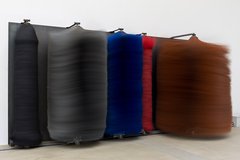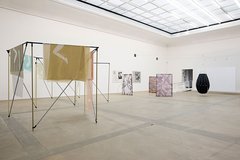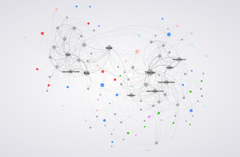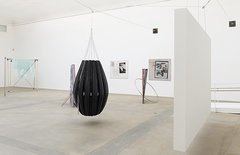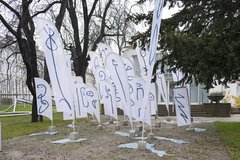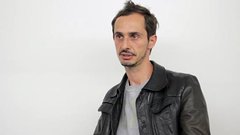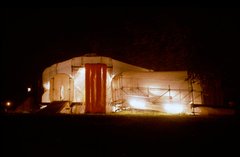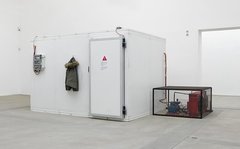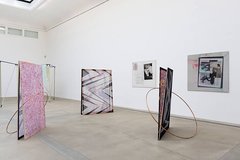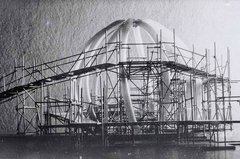Author: Jürgen Dehm
"trigon 67" – Spaces and Dissolved Boundaries
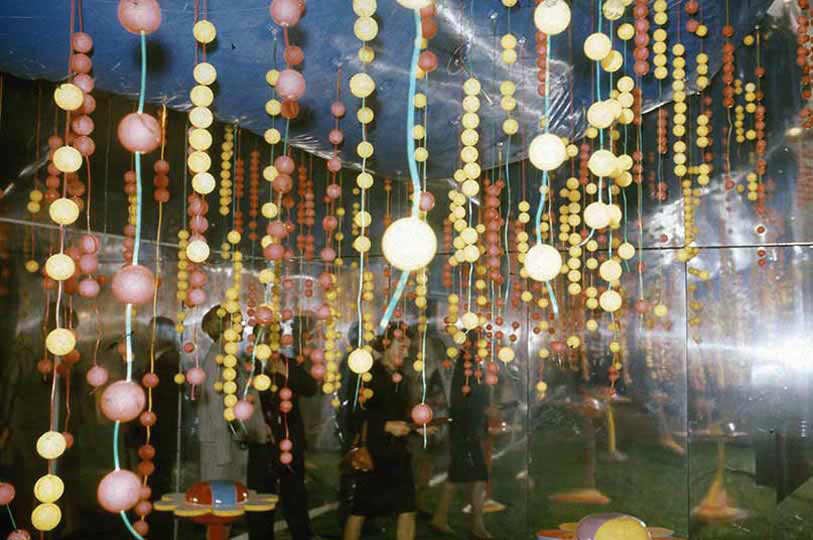
“trigon 67” – Spaces and Dissolved Boundaries
The deputy mayor of Graz, Alexander Götz, did not conceal his opinion about the third edition of the tri-nation biennale “trigon.” Shortly after its opening in September 1967, he vehemently and devastatingly passed judgment on the exhibition in the Graz newspaper Kleine Zeitung: “It is a capital provocation to call Trigon 3 a reflection of the intellectual powers of the present.”[1] The controversy that “trigon 67” sparked—and which led, in the course of Götz’s polemics, to some angry letters to the editor directed against the exhibition—may not have been planned, but it was foreseeable. How did this come to pass in Graz during the autumn of 1967?
The Tri-Nation Biennale “trigon”
The “trigon” biennale was initiated in 1963 by Hanns Koren, who at the time headed the Styrian cultural department.[2] Conceived as a strongly rooted event by the Steirische Akademie, taking place in Graz for the fourth time that year, the exhibition strove to bring together “contemporary painting and sculpture from Italy, Yugoslavia, and Austria,” as the subtitle read.[3] The Steirische Akademie, which brought scholars from all over the world to the state capital every year, but also the Forum Stadtpark, which was planned starting in 1958, finally opened in 1960, and sought to unite different art forms through an interdisciplinary approach, had already been sending far-sighted signals meant to overcome prejudices and mental barriers.
The founding of the tri-nation biennale was not only directed expressly against a bourgeois understanding of art influenced by tradition, as was prevalent in Graz during the second half of the 1960s; “trigon” was also meant to raise awareness for collective cultural space. The activities connecting Austria, the Friuli-Venezia Giulia region of Italy, and Yugoslavia aimed to take a stance against the territorial demarcations undertaken during the war and postwar periods.
All the same: “trigon” debuted as a survey exhibition on current artistic activity in Austria, Italy, and Yugoslavia, yet it was perceived predominately as an art competition between the participating countries. While the exhibition enjoyed high popularity, some of Graz’s citizens—even in the year 1963—expressed a lack of understanding for the abstract art shown there, despite the show’s focus on the traditional genres of painting and sculpture and a conventional presentation.[4] In the “trigon” exhibition of 1965, the complexity arising from the participation of 134 artists was to be countered by a concentraion on only five painters and three sculptors per region.[5] However, this reduction of the number of artists enhanced the competition character—which was further heightened by the lack of an exhibition theme and the still traditional means of presenting the works of art. The impression again arose of a “competition among the countries for the best art.”
The “trigon” biennale started with the aspiration to surmount both factual borders and barricades of the mind, yet in its first two editions some of the exhibition visitors were rather wary due to their conservative appreciation of art. The criticism coming from middle-class circles was well noted by Hanns Koren at the cultural department, but he was not discouraged and thus oriented the concept of the third “trigon” even more strongly toward international developments in the contemporary art scene.
“trigon 67 – ambiente / environment”
Accompanying the third tri-nation biennale, held in 1967, was a more concrete execution of the original exhibition concept. The organization of the event was handed over to Wilfried Skreiner, who the year before had been named director of the Neue Galerie. Supporting him as advisors were Umbro Apollonio, the representative for Italy for the first two “trigon” shows, and Zoran Kržišnik, who had been in charge of the Yugoslavian part since 1965. Thanks to the decision to focus “trigon 67” on explorations of space in contemporary art, a theme for the exhibition was chosen, reflecting one of the most essential tendencies in recent avant-garde art.[6] The art press accepted this downsizing with benevolence, as the statement by Kristian Sotriffer in the Presse illustrates: “Commendable … is this self-imposed limitation … Confrontations like these are valuable and necessary. They clarify one’s own position (that of the artists, the critics, and the audience) and also make connections that no one will underestimate who knows how necessary it is to always reevaluate one’s own thoughts and actions and to willingly open oneself to new insights and realizations. We are surely on the right path in Graz, at least when it comes to the form of the selection and the objective being pursued.”[7] The starting point for selecting this topic was, most especially, the “cut paintings” of Lucio Fontana, which the Italian artist famously used to “force” two-dimensional panel painting into three-dimensional space.[8]
At fifteen participants, the number of involved artists was manageable.[9] The inclusion of architecture as a spatial art form was underscored by the commissioning of the architects Günther Domenig and Eilfried Huth to design the exhibition parcours, which this time was to be presented at the Künstlerhaus and in the directly adjacent city park. The planning group Domenig / Huth had caught the attention of the “trigon 67” organizers with their design of the vertical housing structure “Stadt Ragnitz” and a related exhibition at Forum Stadtpark in 1966 in particular.
With the help of around forty students, Domenig and Huth spent several weeks implementing the exhibition structure as well as supporting the artists and their on-site installations, spatial sculptures, and environments. As an access point for the exhibition, the architects designed a house-high entrance pavilion shaped as a spiral and made of scaffolding and plastic sheets. The idea was for guests to be “transposed into” the exhibition, fully in line with the zeitgeist of expanded consciousness during the 1960s. A multimedia show installed in this pavilion, along with the ticket office and book sales, was also meant to introduce the feel of the works shown in the exhibition. A pneumatic dome made of rubber tubing, intended to cover the scaffolding, could not be completed due to a thunderstorm during assembly, which damaged the tubes.[10]
Sections of scaffolding also lent structure to the main exhibition hall at the Künstlerhaus. In the foyer, the Slovenian artist Jaki Jože Horvat presented stand-up displays created on site featuring a mythical language of form. He tried to evoke a sense of space by painting the additionally installed horizontal pedestal and oblique ceiling sections.
In order to achieve an appropriate presentation of their ideas, several of the artists showing their work inside the Künstlerhaus decided to create room containers. The Italian artist Luciano Fabro, for example, selected for his conceptual approach a white, brightly illuminated, cuboid installation that was separated at the middle into two identical spaces. The structure was given two identical access points, one outside and one in the separating wall of the container, although the entrance to the second room was obscured by a canvas—so it was left up to the imagination of the viewer as to what was situated behind it.
Such a negotiation of the “White Cube” as a realm for exhibition and experience was unusual for the year 1967. For artists engaging with Minimal Art in America, space was a pivotal category. However, the well-known artistic explorations with this topic in Europe did not start until around 1967, for instance with Lawrence Weiner’s removal of a square layer of wall for A 36" X 36" REMOVAL TO THE LATHING OR SUPPORT WALL OF PLASTER OR WALLBOARD FROM A WALL at the exhibition When Attitudes Become Form in Bern or Daniel Buren’s “sealing” of the Galleria Apollinaire in Milan with white-green strips of fabric.[11] It was not until the opening of the famous essay series Inside the White Cube by Brian O’Doherty[12] in the year 1976, in which the relationship between art and (exhibition) space became a point of focus, that the topic caught on with exhibition-makers, artists, and critics. O’Doherty’s text inspired, for example, the Italian curator Germano Celant to invite thirteen artists to the Venice Biennale that year to present, under the heading “Ambiente Arte,” space-encompassing installations.
But now back to the other works in “trigon 67.” In order to arrive at the eight-meter-high tower featuring the spatial installation by Oswald Oberhuber in the exterior space next to the Künstlerhaus, one had to traverse a man-made landscape by Miroslav Šutej with large, bright wooden flowers and raindrops made of painted ping-pong balls. As an environment, Šutej’s work was a clear connector to previous artwork, such as Claes Oldenburg’s “Bedroom Ensemble,” shown in 1964 at Sidney Janis Gallery in New York.
For works shown to the exterior of the Künstlerhaus in the city park, Huth and Domenig had planned a path made of yellow wooden boards. Assigned to the end of each board was a respective artwork with number, matching the exhibition catalogue. An inconspicuous fence was meant to protect the exhibition premises from vandalism. The sculptural works shown there were conceived as open structures: the Slovenian artist Drago Tršar, who had already participated in the tri-nation biennial thrice, stacked up concrete pipes like those used in sewer systems to create a three-level pyramid. The Austrian artist Josef Pillhofer transferred a small bronze sculpture, abstracting a bird, into a large-scale scaffolding structure painted white in the exterior space. Aside from the outside contours, the inner connecting lines and diagonals of his work were visible. Walk-in spaces were shown by Guiseppe Uncini and Roland Goeschl. The former, an Italian artist, presented his Unità Cellulare, a metal sculpture that reflected the contours of a furnished interior space, like an outline drawing, although it integrated the shadows in a different color. Goeschl, born in Salzburg, in turn crafted a “dead end” from polyester components up to four meters high in the primary colors of yellow, red, and blue.
“Shock of the new”
“trigot 67” was an ambitious endeavor. Due to the inclement weather, the architects Domenig and Huth had to rethink their plans, and some of the works created on site were adjusted accordingly. Vjenceslav Richter from Croatia, for example, had originally planned to fashion a cube from glass tubes, with a hemispherical form of approx. 2.5 meters in diameter being “cut out” of the cube. However, the implementation of Richter’s idea turned out to be too complicated. An alternative using concrete failed due to the symmetrical relations between the individual parts. The state of the exhibition remained unfinished long after the opening on September 5, 1967, upon which Otto Breicha also remarked negatively in his commentary in the Kurier: “I visited the Trigon exhibition at Graz’s city park a week after its opening, and all kinds of setup activity was still going on. It was like a rehearsal for the dress rehearsal.”[13]
Another point of criticism noted by Breicha that is consistently cited—such as in Alexander Götz’s polemics mentioned earlier—is the overblown exhibition budget: “The fact that a ‘total’ exhibition (usually only undertaken in exceptional cases due to the related costs and nuisance) devours so much of what merely signifies arranged framed paintings and decorous sculptures on pedestals, well, they should have known better.”[14]
Despite the environments and spatial installations explicitly designed to be experienced, of which some were specially geared toward tactile sensation, and despite the high number of exhibition visitors, the artworks shown were widely met with incomprehension. In the discussion sparked by Alexander Götz’s contribution to the Kleine Zeitung, many people took a position of angry rejection toward the exhibition, for instance: “This mockery of all thinking people, as this exhibition signifies, is not worthy of a critique”[15] or “This so-called art is the joke of the century.”[16] Yet it also inspired the initiators and proponents of “trigon 67” to defend the exhibition, for example Günther Waldorf, director of Forum Stadtpark, who found fault with Götz’s knowledge of art, noting that he had “plenty of opportunities during his many trips abroad … to obtain information about the current state of the international art scene, considering that he meant to make a critical statement on these issues.”[17]
Due to the fierce reactions to “trigon 67,” Wilfried Skreiner, who was responsible for the exhibition, coined an apt phrase: “shock of the new”[18] (“Schock der Moderne”). In the eyes of visitors who had already considered the abstract sculptures shown at the 1963 and 1965 tri-nation biennales outlandish, the installations and environments at the Künstlerhaus were now quite unfathomable. The unusual exhibition architecture likely also had a daunting effect, even if just due to its size. The public doesn’t appear to have been prepared for exploring space through art.
In the catalogue to “trigon 67,” Skreiner emphasized that the selection of the topic “space” for the show had been made “without knowledge of similar exhibition concerns.”[19] As an advisor, the Italian Umbro Apollonio—with his knowledge of Lucio Fontana, for instance his presentation with Sofu Teshigahara, already shown in 1960 at Palazzo Grassi—likely provided the impetus for choosing the topic of space. The fact that this theme was highly topical for art in 1967 was surely clear to all those keeping up with current developments, such as Richard Rubinig. In his preliminary discussion of “trigon 67” in the Kleine Zeitung, he spoke of the relevance of the topic:
“The idea [behind trigon 67] is not to line up paintings and sculptures, but rather to create living space that the architect does not present, incomplete and inalterable, to a given person who, as an individual of his own kind, is meant to help create this ‘ambience.’ Painters, sculptors, and architects are today repeatedly forced to arrive at spatial solutions.”[20]
The investigation of space—a topic that was of central importance not only for the “trigon 67” artists, but also for the exhibition itself, with its display and parcours—appears not to have appealed much to the audience in Graz. However, the rush of visitors was tremendous. In the fifth exhibition week, for example, there were over 12,000 visitors.[21] Despite the dismissive voices, Hanns Koren and the organizers were confident that, with this edition of the “trigon” biennale, they had succeeded in arriving at a high niveau within the international art scene. Indeed, “trigon 67” was one of the essential jumping boards leading to the official founding of the international festival for contemporary art steirischer herbst in Graz a year later, also headed by Hanns Koren.[22] In the scope of the steirischer herbst, on the heels of “trigon 67,” other innovative, thematically focused “trigon” editions were held, such as on architecture in 1969 and on “audiovisual messages” in 1973. The future-oriented nature of the tri-nation biennale was thus clearly demonstrated by “trigon 67.”
- Alexander Götz, “Eine einmalige Provokation!,” Kleine Zeitung (September 16, 1967):11.
- See Gernot Rabl, “Trigon: Idee und Geschichte eines trinationalen Ausstellungskonzepts” PhD diss., Graz: Karl-Franzens-Universität, 2004).
- See Hanns Koren, “Zum Geleit,” in Trigon 63: Malerei und Plastik der Gegenwart aus Italien, Jugoslawien, Österreich, exh. cat. Burggarten, Forum Stadtpark, and Künstlerhaus, September 15 to October 6, 1963 (Graz, 1963): 1–2.
- See Werner Fenz, “‘Trigon’: Kunst als Protokoll der Zeit,” in Die Steiermark: Brücke und Bollwerk, ed. Gerhard Pferschy and Peter Krenn, exh. cat. Landesausstellung Steiermark 1986 (Graz, 1986):519–523, 520–21.
- See Trigon 65: Italien, Jugoslawien, Österreich, exh. cat. Künstlerhaus and Burggarten / Palmenhaus, Graz, September–October 1965 (Graz, 1965).
- Program for “trigon 67,” unpaginated: “trigon 67 is devoted to ambiente / environment and represents the attempt to have the problem of space addressed by painters and sculptors in an exemplary way. Each artist creates an appropriate spatial idea using his own autonomous means.”
- Kristian Sottrifer, “Ein Konzept nahm Form an: Die Dreiländerausstellung ‘Trigon’ in Graz,” Die Presse, (September 14, 1965): 6.
- Fontana had been asked to participate in the founding exhibition of “trigon” in 1963 but did not accept the invitation.
- Participants in “trigon 67:” Austria: Marc Adrian, Roland Goeschl, Oswald Oberhuber, Josef Pillhofer, Rudolf Pointner, Jorrit Tornquist; Italy: Mario Ceroli, Gianni Colombo, Luciano Fabro, Enzo Mari, Giuseppe Uncini; Yugoslavia: Jaki Jože Horvat, Vjenceslav Richter, Miroslav Šutej, Drago Tršar. However, Ivna Picelj, who is also mentioned in the catalogue, did not ultimately participate in the exhibition.
- Some of the inflatable tubes found use in the exhibition as seating areas.
- See Markus Brüderlin, “Die Transformation des White Cube,” in Brian O’Doherty: In der weißen Zelle / Inside the White Cube, ed. Wolfgang Kemp (Berlin, 1996): 138–66, 141.
- Ibid., 143.
- Otto Breicha, “Besser noch nicht benützen! Zur Situation und zu den Problemen der diesjährigen Grazer Trigon-Ausstellung,” Kurier, (8 Septmber 23, 1967): 9.
- Ibid.
- Klaus Turek, “Geschlagener Mann,” Kleine Zeitung, Forum, (September 27, 1967).
- Maria Gaszar, “Der Schmäh des Jahrhunderts,” in ibid.
- Günther Waldorf, “So einfach geht’s nicht, Herr Vizebürgermeister!,” Kleine Zeitung, Forum, (September 21, 1967).
- Wilfried Skreiner, “Biennale Trigon: Geschichte eines Ausstellungskonzepts,” in 8 x 2 aus 7, exh. cat. steirischer herbst 1991, vol. 1. (Graz, 1991): 123–46, 124.
- Wilfried Skreiner, in trigon 67 – ambiente / environment, exh. cat. Künstlerhaus Graz (Graz, 1967), n.p.
- Richard Rubinig, “Auftakt zum steirischen Herbst: Vorschau auf das Grazer Trigon 1967 bei einer Pressekonferenz,” Kleine Zeitung, (August 24, 1967):12.
- Styrian State Archive Graz, Neue Galerie, Trigon 67, contribution: 5. Wochenbericht, Ohne GZ, Graz, October 5, 1967, p. 4, cited in Rabl 2004, p. 37.
- Wilfried Skreiner, “Die Biennale trigon: Geschichte eines Ausstellungskonzepts,” in 8 x 2 aus 7, exh. cat. Steirischer Herbst 1991, vol. 1 (Graz, 1991):123–46, 123. Founding committee in 1968: chair: Hanns Koren (Deputy State Governor, State Government of Styria); members: Emil Breisach (Artistic Director of the ORF Studio Styria), Erich Marckhl (President of the Academy of Music and Performing Arts in Graz), Reinhold Portisch (Secretary General of the Music Society for Styria), Wilfried Skreiner (Director of the Neue Galerie at the Styrian Museum Joanneum), Günter Waldorf (President of Forum Stadtpark). The title “Steirischer Herbst” was already being used in 1967 for the events included later. See Rabl 2004:39. Here, Rabl is referencing Max Reisinger, Steirische Kulturpolitik 1965 bis 1975 – Der Steirische Herbst (Graz, 1994):14.
